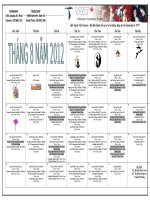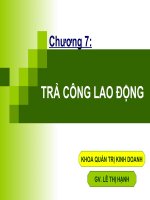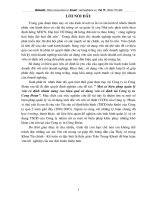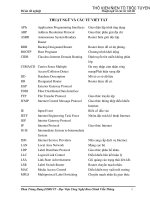Updated im c7 bbacacafa
Bạn đang xem bản rút gọn của tài liệu. Xem và tải ngay bản đầy đủ của tài liệu tại đây (9.44 MB, 33 trang )
CHAPTER 7
DISTRIBUTION
DECISIONS
VTHN
CONTENTS
01
HANDLING THE
EXPORT ORDER
03
DISTRIBUTION CHANNELS:
OBJECTIVES, TERMINOLOGY,
AND STRUCTURE
02
PHYSICAL
DISTRIBUTION
04
GLOBAL RETAILING
INTRODUCTION
●
Access a key decision
●
Can we use the same distribution channels as home markets?
●
Distribution density; channel length; channel alignment; distribution
logistics
●
Distribution channels tend to be longer, but ……
●
Wholesale and retail related to economic development
●
Direct channels provide better control, flexibility and feedback
●
Disintermediation
1. THE EXPORT PROCEDURE
1.1 ORDER RECEIVED DIRECTLY FROM PROSPECTIVE
IMPORTER
•
Order contains the essential facts concerning the
desired merchandise & shippment
•
Exporter send confirmation of receipt
•
Exporter prepare Proforma Invoice (type & amount of
merchandise, unit costs & extensions, expected weights & measures,
terms of sales and payment, etc.)
1.2 ORDER RECEIVED FROM BRANCH OR
REPRESENTATIVE OVERSEAS
•
Use a combination order form and sales contract
•
Exporter accept the order, then complete & sign the
form (both the seller & buyer)
•
Indent order is between final purchaser & overseasbased branch office/ distributor of export
1.3 EXPORT LICENSES
•
Individual countries have their own export laws,
•
Control the export of products for reasons (national
security, foreign policy, short supply, preservation of cultural property,
assisting of industries using domestic products, renvenue purpose)
1.4 FINANCING/ PAYMENT & OTHER
TERMS OF SALE
•
Getting the merchandise from the exporter’s plant to the port
•
Getting the merchandise through outbound Customs
•
Getting the merchandise abroad ship (or other mode of
transport)
•
Paying for the freight
•
Paying for insurance
2 PHYSICAL DISTRIBUTION
•
The passage of goods across national boundaries, with
attendant legal requirements
•
Shipment by ocean-going vessels or international airlines,
with attendants security needs and specific documentary
requirements
•
The time and distance required to complete the
transaction, with attendant needs for ensuring payment
2 PHYSICAL DISTRIBUTION
A positive effect on a company’s sale volume through the
service provided
The speed with which a product can be provided to a
customer
• The reliability with which the average speed of service is
achieved
• The degree of immediate availability of the product
• The arrival of the product in good condition
•
2.1 NATURE OF THE SHIPMENT
•
The minimum size of the unit pack
•
The quantities
•
The type of method of packaging
•
The identification marking
2.2 TRANSPORTATION
•
The external movement of the product
•
Select the mode(s) of transportation
•
Provide adequate insurance coverage
(marine or air insurance)
2.3 WAREHOUSING
• Assembling, breaking bulk shipments into smaller
size
• Prepare products for reshipments
• Determine
ü The number and type of warehousing facilities
ü Spatial arrangement
2.4 MATERIALS HANDLING
Provision must be made for
the internal movement of
products within plants and
warehouse
2.5 CARRY INVENTORY
Cost elements in managing
inventory (storage, interest
on capital tied up, taxes, lost
sales, materials handling,
etc.)
2.6 ORDER PROCESSING & DOCUMENTATION
•
Complexity number of documents & correspondents
•
Culture language, currency, law
•
Change changes in requirements
•
Cost costs of preparation
•
Error consequential costs of error and costs or correction
3 DISTRIBUTION CHANNELS: OBJECTIVES,
TERMINOLOGY, AND STRUCTURE
Marketing channels exist to
create utility for customers
•
Place utility
•
Time utility
•
Form utility
•
Information utility
In B2C marketing consumer
channels are designed to put
products in the hands of people
for their own use
In B2B marketing industrial
channels to deliver products
(inputs) to manufacturers/ other
organizations
3 DISTRIBUTION CHANNELS: OBJECTIVES,
TERMINOLOGY, AND STRUCTURE
Distributor is a wholesale intermediary that
typically carries product lines/brands on a
selective basis
Agent is an intermediary who negotiates
exchange transactions between two or more
parties but does not take title to the goods being
purchased or sold
Six channel
structure
alternatives for
consumer
products
Six channel
structure
alternatives for
industrial/
business
products
3.1 ESTABLISHING CHANNELS AND WORKING WITH
CHANNEL INTERMEDIARIES
●
●
●
●
●
●
●
Select distributors – don’t let them select you!
Look for distributors capable of developing markets, rather than those with a few
good customer contacts.
Treat local distributors as long-term partners, not temporary market-entry
vehicles.
Support market entry by committing money, managers, and proven marketing
ideas.
From the start, maintain control over marketing strategy.
Make sure distributors provide you with detailed market and financial
performance data.
Build links among national distributors at the earliest opportunity.
4.1 TYPES OF RETAIL OPERATIONS
Department
stores
Specialty
retailers
Supermarkets
several
departments
under one roof,
each representing
a distinct
merchandise line
and staffed with a
limited number of
salespeople
narrowly focused
and offer a
relatively narrow
merchandise mix
aimed at a
particular target
market
departmentalize
, single-story
retail
establishments
that offer a
variety of food
and nonfood
Convenience
stores
same products
as
supermarkets,
but the
merchandise
mix is limited to
high-turnover
convenience and
impulse
products
Discount
retailers
the emphasis on
low prices
4.1 TYPES OF RETAIL OPERATIONS
Hard
discounters
limited
assortment of
goods— typically
1,000 to 3,000
different items—
at rock-bottom
prices
Hypermarkets
hybrid retailing
format combining
the discounter,
supermarket, and
warehouse club
approaches under
a single roof
(200,000 to
300,000 square ft)
Superstores
Shopping malls
the label many in group of stores in
the retailing
one place, leisure
industry use when destination
talking about
stores such as
Toys ‘R’ Us, Home
Depot, and IKEA
Outlet stores
dispose of excess
inventory, out-ofdate merchandise,
or factory seconds
4.2 GLOBAL TRENDS
●
●
●
●
●
●
●
●
●
Increased internationalisation of retailing and logistics
Further spread of discounting
Digital retailing on global scale
Growth of mobile shopping
Online sales accelerating in developing markets
3rd party marketplace
Customers seeking experiences & products reflecting
personal brand on social media (Deloitte, 2017)
Amazon disrupting the marketplace
E-Marketplace e.g. Alibaba
“Customers want authentic, sharable experiences to further their personal
brand”
“Retailization of the world - the maker movement, the sharing economy”
“E-commerce continues to be a major growth engine for the retail
industry”
—Deloitte (2017)
4.3 ISSUES IN THE CYBERMARKETPLACE
•
•
•
•
•
•
Digital divide
Growing online shopping, but varied
across world
Diverse credit card culture
Disintermediation process
Cannabalising existing distribution
channels?
Black Friday/Cyber Monday
• Manufacturers competing
•
•
•
•
•
•
with resellers
Channel conflict
Importance of logistics
support
Currency issues
Fraud issues
Communication issues
Drone delivery?









